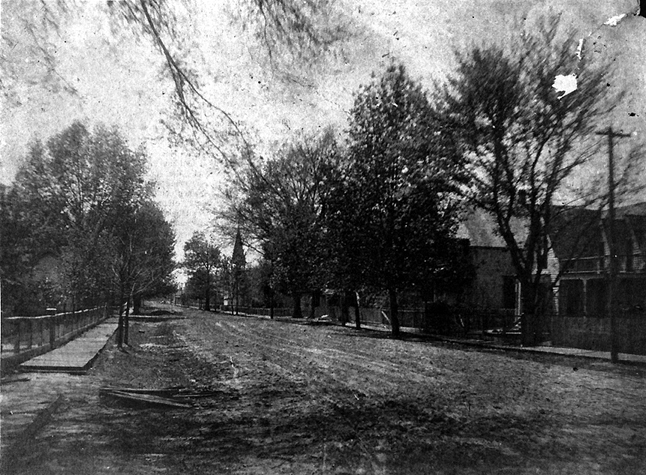
St. James Hotel

From the Clay County Courier:
"Amplification Featuring St. James, The
First"
By J. M. Oliver, Jr.
"This view westward down Pine from First street was made in the fall of 1906. Clue to the date is provided by the Methodist church, the white frame building jutting out into Pine at the far end of the street. The Methodists moved their first church building from its site at the corner of Third and Pine in the fall of 1906, clearing the site for a new brick church that was completed in the spring of 1907. The three-story brick in the foreground is The St. James Hotel, James I, owned and operated by the ever resourceful James E. Matthews. Backing the claim for resourcefulness is inn keeper Jim's solution of the slop jar program in a three-story hotel that had no plumbing to provide water. Jim's brilliant solution of the situation was a rear gallery that made waterless water closets, euphemistically called Chic Sales, available to the rooms on every floor from first to third. With the Robinson Livery Stable on the adjoining block next north, Jim had a perfect out in case of squamish roomer complained about obnoxious odors. What could one expect with so many horses outside his bedroom window!!
"St. James, the First went to his celestial reward in a fiery chariot less than a year after this photograph was made. A balmy mid May night, and a gala evening in Corning for the recently built Opera House was being opened to the public for inspection and approval with a combined Corning Band Concert for music connoisseurs and ice cream supper (for those who had grosser tastes)--Truly and evening to be remembered--
"Jimmie Oliver had just polished off his third saucer and third flavour of ice cream and was lining up, another trio [sic] when the Booser Stave Factory fire whistle with a nerve wracking TOOT TOOT broke up the gathering as effectively as Napoleon's booming cannon had done at Brussells. Down the outside stairs at breakneck speed and then looking south we beheld flames. The local bucket brigade was either in their new band uniforms or in their Sunday-best attire, so all had to scamper home and swap into everyday garments. By the time they were ready for fire fighting, the flames were out of control and St. James was past saving. Attention was turned to saving the furnishings. Fragile furnishings were tossed through the windows--unbreakable items like featherbeds were carefully lugged... [text missing].
"The fire had started in the Lute West bakery, the one story frame immediately east of the hotel. The two story frame residence at the corner had just been vacated by Till Toalson who had moved to the new Toalson home on Missouri avenue. Fire consumed that building as well as the one story frame across Pine to the south. Lute West family lived there so Lute lost both home and business. The Bank of Corning, across Second street west, was saved by favoring winds. One victim of the holocaust was a Corning character, Old Man Jones, a Civil War veteran with flowing white beard and a collection of unusual watch chains that he wore across his chest. He emerged on the second story balcony over Second street raiment in flames. He was rescued but was so badly burned that he died the next day.
"Jim Matthews of the St. James was no one talent man. He had political bees in his bonnet. As a young man he had been the lighter of the street kerosene lamps. Later as a marshall he directed street repairs, jailed law breakers and toted the town's dead animals to their last resting place. Later, he was elected Sheriff and Collector of Clay county [sic]. He made historical scrapbooks out of the old used hotel registers. The collection was given to the Corning Library on his death, and will be featured at the Centennial. Railroad tycoon aspirations busied him in the beginning of a railroad that was routed from Corning north to Williams Switch, just below Moark curve on the St. L. I M & SO, thence west to Palatka, Success and Pacific if his money held out. It didn't, so the W. S., P., S. & P. barely reached mile post one before operation was suspended. Jim was also a dealer in tombstones and sold himself a cement mausoleum for the Matthews family. Inside the tomb, visible thru the iron door grating, was the mouldering coffin of his young son Jim who died in 1902. Atop the tomb was a statue of Little Jim kneeling in prayer with the words "God Bless Everyone". A Sunday afternoon stroll through the graveyard along with a double dog dare to gaze through the iron door at the interior, if accepted, was a certain forerunner of nightmare that night. However glad one was to belong to a family so numerous and a house so small that togetherness was an enforced way of life, and there was always a bed, with a protecting adult therein, available to crawl into for the rest of the night."
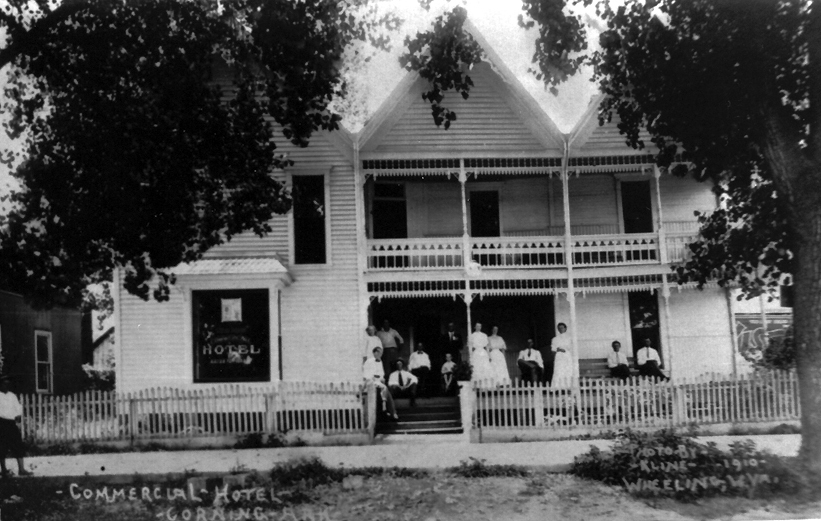
St. James Hotel, Corning, AR.
“St. James Hotel 1910”. From
copy. (Akers).
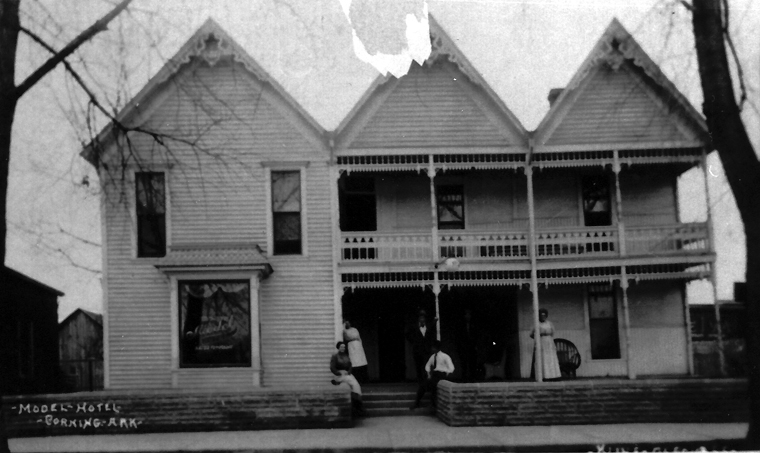
St. James Hotel, Corning, AR.
“St. James Hotel operator a Mrs. Green 1915”.
From copy. (Akers).
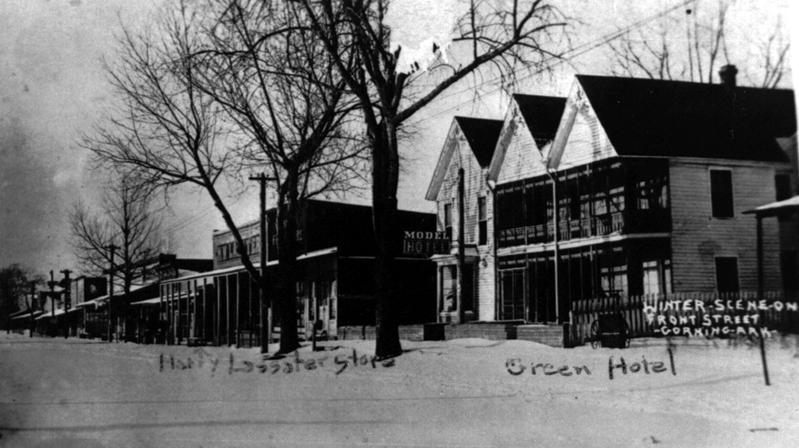
Street scene, Corning, AR.
“Harry Lasater Store, Green Hotel, St. James Hotel, Corning”.
From copy. (Akers).
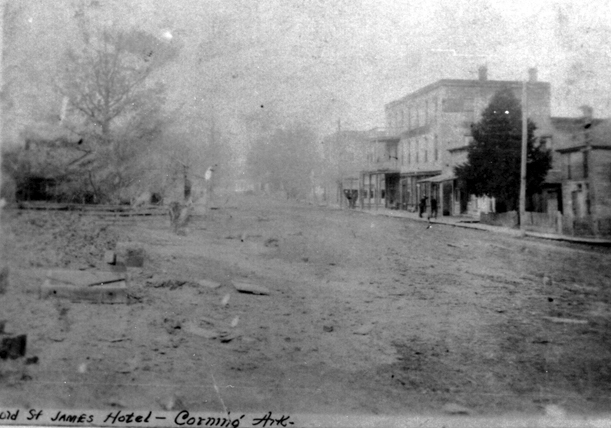
Street scene, Corning, AR.
“3 Story St. James Hotel 1910”.
From copy. (Akers).
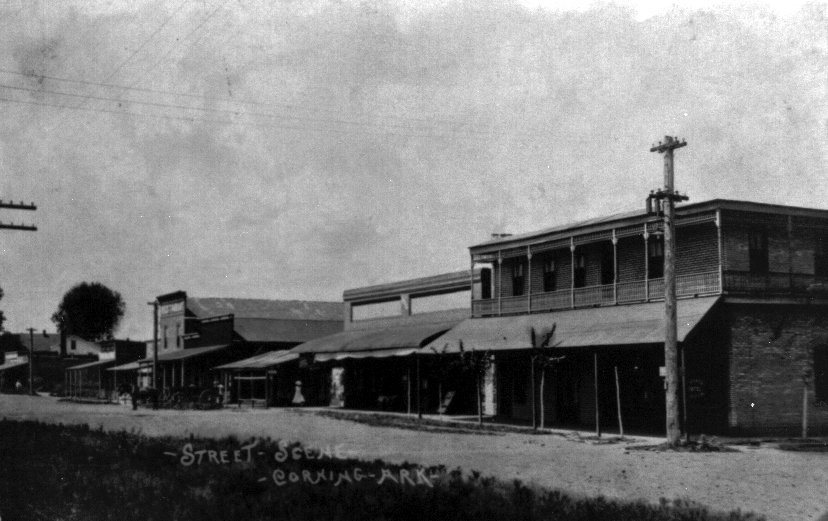
Street scene, Corning, AR.
“St. James Hotel, Corning”. From
copy. (Akers).
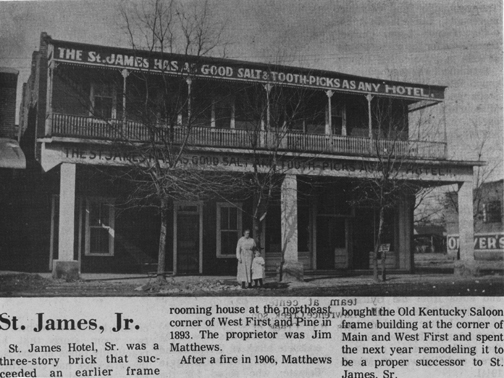
Submitted by Danny Moore